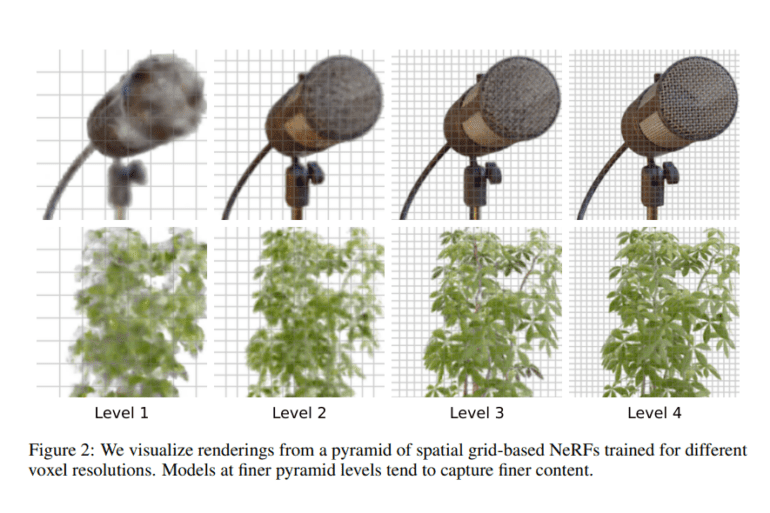TL;DR:
- PyNeRF (Pyramidal Neural Radiance Fields) is a pioneering solution from CMU and Meta to enhance Neural Radiance Fields (NeRFs).
- PyNeRF trains model heads at different grid resolutions, reducing visual distortions without compromising performance.
- It surpasses fast-rendering approaches like Instant-NGP and Nerfacto in both rendering quality and training speed.
- Grid-based techniques in PyNeRF address the slowness and aliasing issues of traditional NeRFs.
- PyNeRF offers versatile partitioning methods, significantly improving visual fidelity while maintaining rendering speed.
- It lowers error rates by 20-90% in synthetic and real-world scenes with minimal performance impact.
- PyNeRF’s future potential includes sharing real-world captures, exploring privacy filtering, and advancing architectural innovations.
Main AI News:
In the realm of neural radiance fields (NeRFs), one critical challenge has persisted: the ability to handle scale variations and eliminate aliasing artifacts in scene reconstruction. This challenge, however, is now being met head-on by a groundbreaking research collaboration between Carnegie Mellon University (CMU) and Meta, introducing PyNeRF (Pyramidal Neural Radiance Fields).
PyNeRF: Scaling the Heights of NeRFs
PyNeRF takes the fundamental concept of NeRFs and elevates it by training model heads at different spatial grid resolutions. This ingenious approach effectively reduces the visual distortions that can plague scene reconstruction at varying camera distances. The beauty of PyNeRF lies in its ability to achieve these improvements without compromising performance, making it a game-changer in accelerating NeRFs while maintaining top-notch scene reconstruction quality.
Grid-Based Revolution
Inspired by the principles of NeRF, PyNeRF delves into grid-based methodologies such as NSVF, Plenoxels, DVGO, TensoRF, K-Planes, and Instant-NGP, aiming to supercharge rendering speed and memory efficiency using voxel grids and tensor approximations.
PyNeRF: The Champion of Speed and Quality
In a head-to-head comparison with other fast-rendering approaches like Instant-NGP and Nerfacto, PyNeRF emerges victorious, not only in rendering quality but also in training speed. It’s a testament to PyNeRF’s prowess in the field.
Tackling the Challenges of NeRFs
While NeRFs have offered remarkable progress in realistic view synthesis, their slowness, primarily attributed to their MLP representation and certain assumptions, has resulted in aliasing issues. Grid-based techniques like Mip-NeRF have tried to accelerate training but faced challenges with positional encodings.
PyNeRF: A Versatile Solution
Drawing inspiration from divide-and-conquer NeRF extensions and classical techniques, PyNeRF introduces a pyramid of models sampled along rays and a novel partitioning approach. This innovation not only enhances rendering quality but also maintains the speed of accelerated NeRF implementations, presenting an adaptable solution for efficient and high-quality novel view synthesis.
Pushing the Boundaries
The researchers behind PyNeRF propose modifying grid-based models and training model heads at varying spatial grid resolutions to render larger volume samples. Using SUDS as the backbone model, they progressively train at higher resolutions. Various grid-based acceleration methods are explored, including the storage of learned features in structures like voxel grids or hash tables.
PyNeRF’s Primary Contribution
At the heart of PyNeRF’s impact lies a versatile partitioning method that amplifies visual fidelity while safeguarding rendering speed in any existing grid-rendering approach.
Superior Quality, Unmatched Speed
PyNeRF stands as a testament to its capability, significantly enhancing rendering quality while reducing error rates by a remarkable 20-90% in both synthetic and real-world scenes, all while maintaining minimal performance impact. In comparison to Mip-NeRF, it achieves a 20% error reduction while training over 60 times faster, converges to SUDS quality in a mere 2 hours, and outperforms baselines in various metrics.
A Bright Future Beckons
As we conclude our exploration of PyNeRF, we witness its remarkable progress in enhancing anti-aliasing features in fast volumetric renderers. It shines brightly across diverse datasets and encourages the sharing of real-world captures to further the frontier of neural volumetric rendering. However, it does so with a mindful eye on potential security and privacy risks inherent in constructing high-quality neural representations.
A Call for Future Endeavors
The road ahead holds promising directions for research. Sharing additional real-world captures and investigating alternative mapping functions for integration volume allocation to hierarchy levels could yield valuable insights. Moreover, the integration of semantic information for privacy filtering during model training presents an intriguing avenue. Architectural explorations to enhance visual fidelity in fast NeRF approaches remain ripe for exploration, as does extending the pyramidal approach to other accelerated NeRF implementations.
Conclusion:
PyNeRF’s introduction represents a groundbreaking leap in the field of neural radiance fields. Its ability to address scale variations, reduce aliasing artifacts, and enhance rendering quality while preserving speed positions it as a game-changer in the market of scene reconstruction. PyNeRF’s versatility and future research prospects underscore its potential to shape the future of efficient and high-quality novel view synthesis, making it a technology to watch closely for businesses and professionals in the field.

